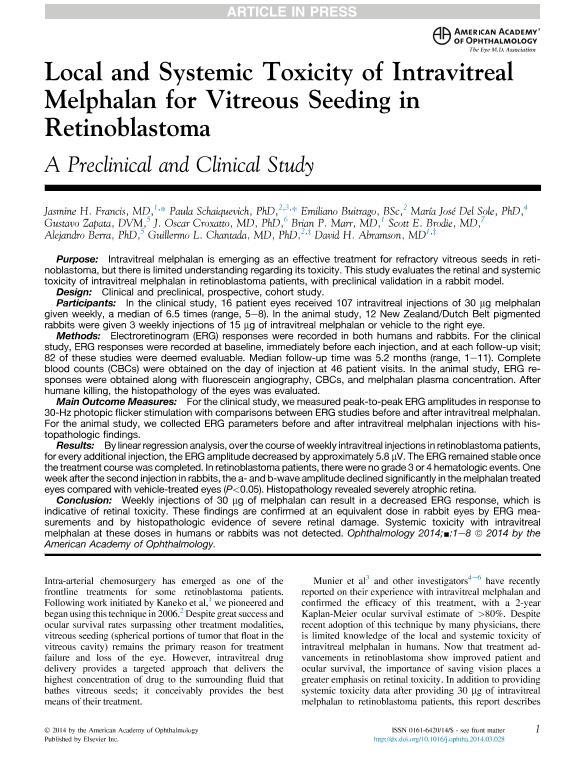Artículo
Local and Systemic Toxicity of Intravitreal Melphalan for Vitreous Seeding in Retinoblastoma: A Preclinical and Clinical Study
Francis, Jasmine H.; Schaiquevich, Paula Susana ; Buitrago, Emiliano; del Sole, Maria Jose
; Buitrago, Emiliano; del Sole, Maria Jose ; Zapata, Gustavo; Croxatto, Juan Oscar
; Zapata, Gustavo; Croxatto, Juan Oscar ; Marr, Brian P.; Brodie, Scott E.; Berra, Alejandro; Chantada, Guillermo Luis
; Marr, Brian P.; Brodie, Scott E.; Berra, Alejandro; Chantada, Guillermo Luis ; Abramson, David
; Abramson, David
 ; Buitrago, Emiliano; del Sole, Maria Jose
; Buitrago, Emiliano; del Sole, Maria Jose ; Zapata, Gustavo; Croxatto, Juan Oscar
; Zapata, Gustavo; Croxatto, Juan Oscar ; Marr, Brian P.; Brodie, Scott E.; Berra, Alejandro; Chantada, Guillermo Luis
; Marr, Brian P.; Brodie, Scott E.; Berra, Alejandro; Chantada, Guillermo Luis ; Abramson, David
; Abramson, David
Fecha de publicación:
09/2014
Editorial:
Elsevier Science Inc
Revista:
American Journal Of Ophthalmology
ISSN:
0002-9394
Idioma:
Inglés
Tipo de recurso:
Artículo publicado
Clasificación temática:
Resumen
Purpose Intravitreal melphalan is emerging as an effective treatment for refractory vitreous seeds in retinoblastoma, but there is limited understanding regarding its toxicity. This study evaluates the retinal and systemic toxicity of intravitreal melphalan in retinoblastoma patients, with preclinical validation in a rabbit model. Design Clinical and preclinical, prospective, cohort study. Participants In the clinical study, 16 patient eyes received 107 intravitreal injections of 30 μg melphalan given weekly, a median of 6.5 times (range, 5–8). In the animal study, 12 New Zealand/Dutch Belt pigmented rabbits were given 3 weekly injections of 15 μg of intravitreal melphalan or vehicle to the right eye. Methods Electroretinogram (ERG) responses were recorded in both humans and rabbits. For the clinical study, ERG responses were recorded at baseline, immediately before each injection, and at each follow-up visit; 82 of these studies were deemed evaluable. Median follow-up time was 5.2 months (range, 1–11). Complete blood counts (CBCs) were obtained on the day of injection at 46 patient visits. In the animal study, ERG responses were obtained along with fluorescein angiography, CBCs, and melphalan plasma concentration. After humane killing, the histopathology of the eyes was evaluated. Main Outcome Measures For the clinical study, we measured peak-to-peak ERG amplitudes in response to 30-Hz photopic flicker stimulation with comparisons between ERG studies before and after intravitreal melphalan. For the animal study, we collected ERG parameters before and after intravitreal melphalan injections with histopathologic findings. Results By linear regression analysis, over the course of weekly intravitreal injections in retinoblastoma patients, for every additional injection, the ERG amplitude decreased by approximately 5.8 μV. The ERG remained stable once the treatment course was completed. In retinoblastoma patients, there were no grade 3 or 4 hematologic events. One week after the second injection in rabbits, the a- and b-wave amplitude declined significantly in the melphalan treated eyes compared with vehicle-treated eyes (P<0.05). Histopathology revealed severely atrophic retina. Conclusions Weekly injections of 30 μg of melphalan can result in a decreased ERG response, which is indicative of retinal toxicity. These findings are confirmed at an equivalent dose in rabbit eyes by ERG measurements and by histopathologic evidence of severe retinal damage. Systemic toxicity with intravitreal melphalan at these doses in humans or rabbits was not detected.
Palabras clave:
Erg
,
Electroretinogram
,
Rpe
,
Retinal Pigment Epithelium
Archivos asociados
Licencia
Identificadores
Colecciones
Articulos(SEDE CENTRAL)
Articulos de SEDE CENTRAL
Articulos de SEDE CENTRAL
Citación
Francis, Jasmine H.; Schaiquevich, Paula Susana; Buitrago, Emiliano; del Sole, Maria Jose; Zapata, Gustavo; et al.; Local and Systemic Toxicity of Intravitreal Melphalan for Vitreous Seeding in Retinoblastoma: A Preclinical and Clinical Study; Elsevier Science Inc; American Journal Of Ophthalmology; 121; 9; 9-2014; 1810-1817
Compartir
Altmétricas



